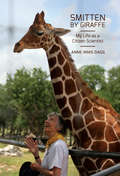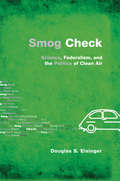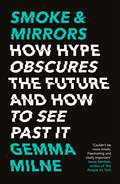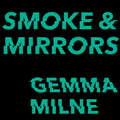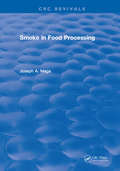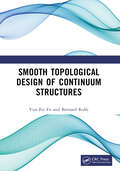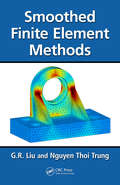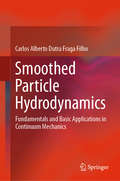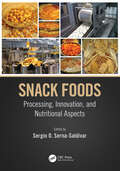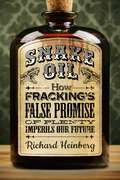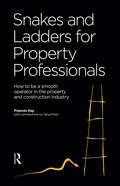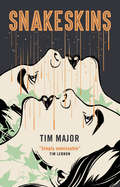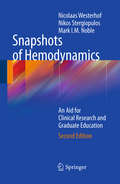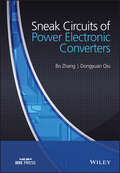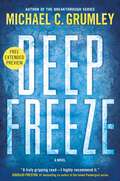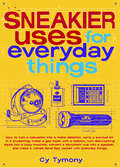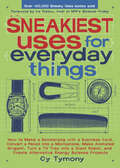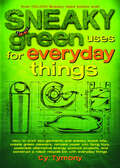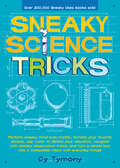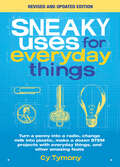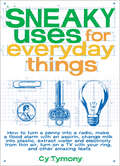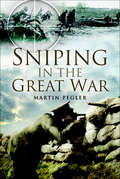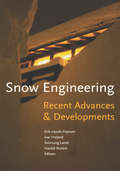- Table View
- List View
Smitten by Giraffe: My Life as a Citizen Scientist (Footprints Series #28)
by Anne Innis DaggWhen Anne Innis saw her first giraffe at the age of three, she was smitten. She knew she had to learn more about this marvelous animal. Twenty years later, now a trained zoologist, she set off alone to Africa to study the behaviour of giraffe in the wild. Subsequently, Jane Goodall and Dian Fossey would be driven by a similar devotion to study the behaviour of wild apes. In Smitten by Giraffe, the noted feminist reflects on her scientific work as well as the leading role she has played in numerous activist campaigns. On returning home to Canada, Anne married physicist Ian Dagg, had three children, published a number of scientific papers, taught at several local universities, and in 1967 earned her PhD in biology at the University of Waterloo. Dagg was continually frustrated in her efforts to secure a position as a tenured professor despite her many publications and exemplary teaching record. Finally she opted instead to pursue her research as an independent “citizen scientist,” while working part-time as an academic advisor. Dagg would spend many years fighting against the marginalization of women in the arts and sciences. Boldly documenting widespread sexism in universities while also discussing Dagg’s involvement with important zoological topics such as homosexuality, infanticide, sociobiology, and taxonomy, Smitten by Giraffe offers an inside perspective on the workings of scientific research and debate, the history of academia, and the rise of second-wave feminism.
Smog Check: "Science, Federalism, and the Politics of Clean Air"
by Douglas S. EisingerWhen federal and state governments battle over environmental regulations, whose approach should prevail? Shortly after passage of the 1990 Clean Air Act Amendments, a controversial U.S. EPA mandate led to an intense conflict between federal regulators and California politicians. The disagreement pitted EPA's required overhaul of auto inspections against California's desire to self-govern its test program - popularly called 'Smog Check.' The conflict nearly upended the Clean Air Act, and triggered dramatic policy shifts throughout the United States. Smog Check presents these struggles in first-hand detail. Eisinger, an EPA official at the time of this conflict, probes deeply into the issues and explores broader questions including: when does it become imperative for agencies to bargain with one another, when should regulatory flexibility and performance-based regulations be favored over command and control approaches, and what should be done when decisions need to be made in the face of scientific disagreement? The book also includes insightful commentary from other EPA participants in the Smog Check controversy. Smog Check's lessons will be relevant to climate change, air pollution control, and numerous other policy challenges.
Smoke & Mirrors: How Hype Obscures the Future and How to See Past It
by Gemma Milne'Stop following the news until you've read Gemma Milne's persuasive analysis of the hype and bullshit that distort our understanding of emerging science. As she shows, the starting point to grasping the genuine opportunities of AI, life sciences and climate tech is a healthy dose of critical thinking'David Rowan, founding editor of WIRED UK and author of Non-Bullshit Innovation: Radical Ideas from the World's Smartest Minds'Couldn't be more timely. Fascinating and vitally important'Jamie Bartlett, author of The People Vs Tech'A much-needed blast of fresh air! Gemma Milne expertly shows us how to separate the truth from the hype surrounding the emerging techs of today, and those of the near-tomorrow'Lewis Dartnell, author of Origins: How the Earth Made Us'I loved this book! This is exactly the sort of sceptical, cut-through-the crap-but-still-excited-about-what's-emerging book around tech innovation that's sorely needed, yet is so hard to find . . . essential reading for anyone who's serious about how real-world advances might be effectively harnessed to build a better future'Dr Andrew Maynard, scientist and author of Films from the Future and Future Rising'[A] vital contribution in a world where technological progress promises so much, but too often disappoints. If, like me, you believe that advances in science and technology are our best hope for solving the grand challenges of our times, this book is the indispensable guide to avoiding the mirages and the charlatans along the way'Matt Clifford, co-founder and CEO of Entrepreneur First'A refreshingly grown-up, clear-headed look at the interaction between science, technology and the media - readable without being dumbed down, acknowledging complexities without being heavy'Tom Chivers, author of The AI Does Not Hate You'ROBOTS WILL STEAL YOUR JOB!''AI WILL REVOLUTIONISE FARMING!''GENETIC EDITING WILL CURE CANCER!'Bombastic headlines about science and technology are nothing new. To cut through the constant stream of information and misinformation on social media, or grab the attention of investors, or convince governments to take notice, strident headlines or bold claims seem necessary to give complex, nuanced information some wow factor.But hype has a dark side, too.It can mislead. It can distract. It can blinker us from seeing what is actually going on.From AI, quantum computing and brain implants, to cancer drugs, future foods and fusion energy, science and technology journalist Gemma Milne reveals hype to be responsible for fundamentally misdirecting or even derailing crucial progress.Hype can be combated and discounted, though, if you're able to see exactly where, how and why it is being deployed.This book is your guide to doing just that.
Smoke & Mirrors: How Hype Obscures the Future and How to See Past It
by Gemma Milne'Stop following the news until you've read Gemma Milne's persuasive analysis of the hype and bullshit that distort our understanding of emerging science. As she shows, the starting point to grasping the genuine opportunities of AI, life sciences and climate tech is a healthy dose of critical thinking'David Rowan, founding editor of WIRED UK and author of Non-Bullshit Innovation: Radical Ideas from the World's Smartest Minds'Couldn't be more timely. Fascinating and vitally important'Jamie Bartlett, author of The People Vs Tech'A much-needed blast of fresh air! Gemma Milne expertly shows us how to separate the truth from the hype surrounding the emerging techs of today, and those of the near-tomorrow'Lewis Dartnell, author of Origins: How the Earth Made Us'I loved this book! This is exactly the sort of sceptical, cut-through-the crap-but-still-excited-about-what's-emerging book around tech innovation that's sorely needed, yet is so hard to find . . . essential reading for anyone who's serious about how real-world advances might be effectively harnessed to build a better future'Dr Andrew Maynard, scientist and author of Films from the Future and Future Rising'[A] vital contribution in a world where technological progress promises so much, but too often disappoints. If, like me, you believe that advances in science and technology are our best hope for solving the grand challenges of our times, this book is the indispensable guide to avoiding the mirages and the charlatans along the way'Matt Clifford, co-founder and CEO of Entrepreneur First'A refreshingly grown-up, clear-headed look at the interaction between science, technology and the media - readable without being dumbed down, acknowledging complexities without being heavy'Tom Chivers, author of The AI Does Not Hate You'ROBOTS WILL STEAL YOUR JOB!''AI WILL REVOLUTIONISE FARMING!''GENETIC EDITING WILL CURE CANCER!'Bombastic headlines about science and technology are nothing new. To cut through the constant stream of information and misinformation on social media, or grab the attention of investors, or convince governments to take notice, strident headlines or bold claims seem necessary to give complex, nuanced information some wow factor.But hype has a dark side, too.It can mislead. It can distract. It can blinker us from seeing what is actually going on.From AI, quantum computing and brain implants, to cancer drugs, future foods and fusion energy, science and technology journalist Gemma Milne reveals hype to be responsible for fundamentally misdirecting or even derailing crucial progress.Hype can be combated and discounted, though, if you're able to see exactly where, how and why it is being deployed.This book is your guide to doing just that.
Smoke & Mirrors: How Hype Obscures the Future and How to See Past It
by Gemma Milne'Stop following the news until you've read Gemma Milne's persuasive analysis of the hype and bullshit that distort our understanding of emerging science. As she shows, the starting point to grasping the genuine opportunities of AI, life sciences and climate tech is a healthy dose of critical thinking'David Rowan, founding editor of WIRED UK and author of Non-Bullshit Innovation: Radical Ideas from the World's Smartest Minds'Couldn't be more timely. Fascinating and vitally important'Jamie Bartlett, author of The People Vs Tech'A much-needed blast of fresh air! Gemma Milne expertly shows us how to separate the truth from the hype surrounding the emerging techs of today, and those of the near-tomorrow'Lewis Dartnell, author of Origins: How the Earth Made Us'I loved this book! This is exactly the sort of sceptical, cut-through-the crap-but-still-excited-about-what's-emerging book around tech innovation that's sorely needed, yet is so hard to find . . . essential reading for anyone who's serious about how real-world advances might be effectively harnessed to build a better future'Dr Andrew Maynard, scientist and author of Films from the Future and Future Rising'[A] vital contribution in a world where technological progress promises so much, but too often disappoints. If, like me, you believe that advances in science and technology are our best hope for solving the grand challenges of our times, this book is the indispensable guide to avoiding the mirages and the charlatans along the way'Matt Clifford, co-founder and CEO of Entrepreneur First'A refreshingly grown-up, clear-headed look at the interaction between science, technology and the media - readable without being dumbed down, acknowledging complexities without being heavy'Tom Chivers, author of The AI Does Not Hate You'ROBOTS WILL STEAL YOUR JOB!''AI WILL REVOLUTIONISE FARMING!''GENETIC EDITING WILL CURE CANCER!'Bombastic headlines about science and technology are nothing new. To cut through the constant stream of information and misinformation on social media, or grab the attention of investors, or convince governments to take notice, strident headlines or bold claims seem necessary to give complex, nuanced information some wow factor.But hype has a dark side, too.It can mislead. It can distract. It can blinker us from seeing what is actually going on.From AI, quantum computing and brain implants, to cancer drugs, future foods and fusion energy, science and technology journalist Gemma Milne reveals hype to be responsible for fundamentally misdirecting or even derailing crucial progress.Hype can be combated and discounted, though, if you're able to see exactly where, how and why it is being deployed.This book is your guide to doing just that.
Smoke in Food Processing
by Joseph A. MagaSmoking was one of the first forms of food processing, and through the centuries the chemistry of smoke has slowly evolved.It is now known that wood and food composition can significantly influence smoke composition, as well as the resulting textual, sensory, nutritional, antioxidative, and antimicrobial properties of the smoked food.Aside from beneficial properties, one must also consider potential health concerns associated with certain woods and their resulting smoke.
Smooth Topological Design of Continuum Structures
by Yun-Fei Fu Bernard RolfeSmooth Topological Design of Continuum Structures focuses on the use of a newly-proposed topology algorithm for structural optimization called Smooth-Edged Material Distribution for Optimizing Topology (SEMDOT).The book presents the basic theory of SEMDOT and explains connections between this method and the corresponding optimizers. The method is used to address the long-standing jagged edge problem facing classical topology optimization algorithms and is presented as a perfect tool for combining additive manufacturing and topology optimization, which are increasingly coupled together to produce new part designs. A range of representative case studies are also included to illustrate applications.This serves as a textbook and reference for graduate and senior undergraduate students in the area, as well as engineers in the structural optimization field. Full modifiable MATLAB codes for each chapter are available online.
Smoothed Finite Element Methods
by G.R. Liu Nguyen TrungGenerating a quality finite element mesh is difficult and often very time-consuming. Mesh-free methods operations can also be complicated and quite costly in terms of computational effort and resources. Developed by the authors and their colleagues, the smoothed finite element method (S-FEM) only requires a triangular/tetrahedral mesh to achieve mo
Smoothed Particle Hydrodynamics: Fundamentals and Basic Applications in Continuum Mechanics
by Carlos Alberto Dutra Fraga FilhoThis book is based on results obtained over a decade of study and research. It questions the use of dynamic molecular models in the continuum scale providing alternative solutions to open problems in the literature. It provides a physical-mathematical understanding of the differential equations that govern fluid flow and energy transport, serving as a reference to the application of Smoothed Particle Hydrodynamics in continuum fluid mechanics and transport phenomena. The physical-mathematical modelling of the problems in the continuum scale and the employment of the SPH method for solving the equations are presented. Examples of applications in continuum fluid mechanics with numerical results and discussions are also provided. This literature defends the concepts of continuum mechanics and the application of boundary treatment techniques that do not violate the laws of physics.
Snack Foods: Processing, Innovation, and Nutritional Aspects
by Sergio O. Serna-SaldivarThe diverse segments of the snack industries that generate close to $520 billion of annual sales are adapting to new consumer´s expectations, especially in terms of convinience, flavor, shelf life, and nutritional and health claims. Snack Foods: Processing, Innovation, and Nutritional Aspects was conceptualized to thoroughly cover practical and scientific aspects related to the chemistry, technology, processing, functionality, quality control, analysis, and nutrition and health implications of the wide array of snacks derived from grains, fruits/vegetables, milk and meat/poultry/seafood. This book focuses on novel topics influencing food product development like innovation, new emerging technologies and the manufacturing of nutritious and health-promoting snacks with a high processing efficiency. The up-to-date chapters provide technical reviews emphasising flavored salty snacks commonly used as finger foods, including popcorn, wheat-based products (crispbreads, pretzels, crackers), lime-cooked maize snacks (tortilla chips and corn chips), extruded items (expanded and half products or pellets), potato chips, peanuts, almonds, tree nuts, and products derived from fruits/vegetables, milk, animal and marine sources. Key Features: Describes traditional and novel processes and unit operatios used for the industrial production of plant and animal-based snacks. Depicts major processes employed for the industrial production of raw materials, oils, flavorings and packaging materials used in snack food operations. Contains relevant and updated information about quality control and nutritional attributes and health implications of snack foods. Includes simple to understand flowcharts, relevant information in tables and recent innovations and trends. Divided into four sections, Snack Foods aims to understand the role of the major unit operations used to process snacks like thermal processes including deep-fat frying, seasoning, packaging and the emerging 3-D printing technology. Moreover, the book covers the processing and characteristics of the most relevant raw materials used in snack operations like cereal-based refined grits, starches and flours, followed by chapters for oils, seasoning formulations and packaging materials. The third and most extensive part of the book is comprised of several chapters which describe the manufacturing and quality control of snacks mentioned above. The fourth section is comprised of two chapters related to the nutritional and nutraceutical and health-promoting properties of all classes of snacks discussed herein.
Snake Oil: How Fracking's False Promise of Plenty Imperils Our Future
by Richard HeinbergThe rapid spread of hydraulic fracturing ("fracking") has temporarily boosted US natural gas and oil production ... and sparked a massive environmental backlash in communities across the country. The fossil fuel industry is trying to sell fracking as the biggest energy development of the century, with slick promises of American energy independence and benefits to local economies. SNAKE OIL casts a critical eye on the oil-industry hype that has hijacked America's energy conversation. This is the first book to look at fracking from both economic and environmental perspectives, informed by the most thorough analysis of shale gas and oil drilling data ever undertaken. Is fracking the miracle cure-all to our energy ills, or a costly distraction from the necessary work of reducing our fossil fuel dependence?
Snake Robots
by Kristin Y. Pettersen Øyvind Stavdahl Jan Tommy Gravdahl Pål LiljebäckSnake Robots is a novel treatment of theoretical and practical topics related to snake robots: robotic mechanisms designed to move like biological snakes and able to operate in challenging environments in which human presence is either undesirable or impossible. Future applications of such robots include search and rescue, inspection and maintenance, and subsea operations. Locomotion in unstructured environments is a focus for this book. The text targets the disparate muddle of approaches to modelling, development and control of snake robots in current literature, giving a unified presentation of recent research results on snake robot locomotion to increase the reader's basic understanding of these mechanisms and their motion dynamics and clarify the state of the art in the field. The book is a complete treatment of snake robotics, with topics ranging from mathematical modelling techniques, through mechatronic design and implementation, to control design strategies. The development of two snake robots is described and both are used to provide experimental validation of many of the theoretical results. Snake Robots is written in a clear and easily understandable manner which makes the material accessible by specialists in the field and non-experts alike. Numerous illustrative figures and images help readers to visualize the material. The book is particularly useful to new researchers taking on a topic related to snake robots because it provides an extensive overview of the snake robot literature and also represents a suitable starting point for research in this area.
Snakes and Ladders for Property Professionals
by Frances Kaye Tanya RossThis book is for all those seeking to maximise the effectiveness of their professional relationships in order to reach the top of the property or construction industries. It is written to help young professionals at the early stages of their careers increase their understanding of others and to help more experienced practitioners gain additional skills on their way to the top. It guides you through the intricate steps of professional relationship building – internally for positive staff relationships and proactive teams as well as externally for smooth project management, delivery and business development. It contains advice that all ambitious professionals will find helpful: strategies to help you make the most of your strengths and optimise any opportunities that may present themselves. It is generously sprinkled with cases studies, some of which will cover familiar territory, others will act as a useful warning. Anyone choosing a career in the property and construction profession will benefit from reading this book. Whatever your level of seniority, the tips and tactics will help you to spot and avoid those slippery snakes and climb the ladders to the top.
Snakeskins
by Tim MajorAn SF thriller examining the repercussions of rejuvenation and cloning on individuals' sense of identity and on wider society.Caitlin Hext's first shedding ceremony is imminent, but she's far from prepared to produce a Snakeskin clone. When her Skin fails to turn to dust as expected, she must decide whether she wishes the newcomer alive or dead. Worse still, it transpires that the Hext family may be of central importance to the survival of Charmers, a group of people with the inexplicable power to produce duplicates every seven years and, in the process, rejuvenate. In parallel with reporter Gerry Chafik and government aide Russell Handler, Caitlin must prevent the Great British Prosperity Party from establishing a corrupt new world order.Snakeskins is an SF thriller examining the repercussions of rejuvenation and cloning on individuals' sense of identity and on wider society, with the tone of classic John Wyndham stories and the multi-strand storytelling style of modern TV series such as Channel 4's Humans.
Snapshots of Hemodynamics
by Nicolaas Westerhof Nikos Stergiopulos Mark I.M. NobleThis book is written to help clinical and basic researchers, as well as graduate students, in the understanding of hemodynamics. Recent developments in genetics and molecular biology as well as new non-invasive measurement techniques, make it possible to measure and understand the hemodynamics of heart and vessels better than ever before. Hemodynamics make it possible to characterize, in a quantitative way, the function of the heart and the arterial system, thereby producing information about what genetic and molecular processes are of importance for cardiovascular function. The layout of the book provides a short and essential overview of individual topics. It is designed as a quick reference guide and each chapter can stand alone. The chapters are written to define the basic and applied principles of the hemodynamic topic. If more details or broader perspectives are desired, the reader can refer to related chapters to which the text refers, or the textbooks listed in the 'Reference books' section in Appendix 5. Each chapter starts with a 'box' containing a figure and caption that give the basic aspects of each topic. Chapters end with the section, 'Physiological and Clinical Relevance' that puts the information from the chapter into perspective. The section in between, 'Description', can be used to get more detailed information and find relevant references.
Sneak Circuits of Power Electronic Converters (Wiley - IEEE)
by Bo Zhang Dongyuan QiuThe first treatment of advanced knowledge of electrical sneak circuits and its analysis method in power electronics The work on sneak circuit and its analysis methods for power converters contributes to the reliability of power electronic systems worldwide. Most books in the subject concentrate on electronic systems, but this book is perhaps the first to examine power electronic systems. It describes the sneak circuit phenomena in power converters, introduces some SCA methods for power electronic systems and proposes how to eliminate and make use of sneak circuits. The book is divided into three separate sections. Firstly, the sneak circuit paths and sneak circuit operating conditions are discussed in different kinds of power converters, including resonant switched capacitor converters, basic DC-DC converters, soft-switching converters and Z-source converters; Secondly, the sneak circuit analysis guidelines for power converters based on generalized matrix, adjacency matrix and Boolean matrix are presented respectively; Thirdly, the sneak circuit elimination techniques are introduced and verified in several power converters, with applications of sneak circuits described in conclusion. Written by a lead author with extensive academic and industrial experience, the book provides a complete introduction and reference to students and professionals alike. Contents include: Fundamental Concepts, SCA of Resonant Switched Capacitor Converters, SC of DC-DC Converters, SC Analysis Method (including Boolian Matrix), and Applications of SC in Power Converters. Highlights the advanced research works in the sneak circuit analysis, by a leading author in the field Original in its treatment of power electronics converters; most other books concentrating on electronics systems, and aimed at both introductory and advanced levels Offers guidelines for industry professionals involved in the design of power electronic systems, enabling early detection of potential problems Essential reading for Graduate students in Electrical Engineering: Engineers and Researchers in Power Electronics
Sneak Peek for Deep Freeze
by Michael C. GrumleyFrom the bestselling author of the Breakthrough series: In his next near-future thriller, Michael C. Grumley explores humanity’s thirst for immortality—at any cost... Download a FREE sneak peek today!“A fast-paced juggernaut of a story, where revelations pile upon revelations, building to a stunning conclusion that will leave readers clamoring for more.” —James Rollins, #1 New York Times bestselling author of the Sigma Force seriesThe accident came quickly. With no warning. In the dead of night, a precipitous plunge into a freezing river trapped everyone inside the bus. It was then that Army veteran John Reiff’s life came to an end. Extinguished in the sudden rush of frigid water.There was no expectation of survival. None. Let alone waking up beneath blinding hospital lights. Struggling to move, or see, or even breathe. But the doctors assure him that everything is normal. That things will improve. And yet, he has a strange feeling that there's something they're not telling him.As Reiff's mind and body gradually recover, he becomes certain that the doctors are lying to him. One-by-one, puzzle pieces are slowly falling into place, and he soon realizes that things are not at all what they seem. Critical information is being kept from him. Secrets. Supposedly for his own good. But who is doing this? Why? And the most important question: can he keep himself alive long enough to uncover the truth?At the Publisher's request, this title is being sold without Digital Rights Management Software (DRM) applied.
Sneakier Uses for Everyday Things: Power Devices With Your Plants, Modify High-tech Toys, Turn A Penny Into A Battery, And More (Sneaky Books #2)
by Cy TymonyThe author of Sneaky Uses for Everyday Things is back with an all-new compendium of creative inventions you can make at home. Did you know that your standard issue of Sports Illustrated can be turned into more than twenty useful gadgets? In Sneakier Uses for Everyday Things, Cy Tymony reveals how an ordinary magazine can become many extraordinary gadgets such as a compass, hearing aid, magnifier, peashooter, and bottle opener. Sneakier Uses for Everyday Things covers forty educational and unique projects that anybody can successfully complete with simple household items. The book includes a list of necessary materials, detailed sketches, and step-by-step instructions for each gadget and gizmo. Among the sneaky schemes are: * Creating a electroscope out of a glass jar * Turning a drinking cup into a speaker * Using an AM radio as a metal detector * Making a spy gadget jacket with over twenty individual sneaky uses ranging from a siren and whistle to a walkie-talkie and voice recorder
Sneakiest Uses for Everyday Things: How to Make a Boomerang with a Business Card, Convert a Pencil into a Microphone, Make Animated Origami, Turn a TV Tray into a Giant Robot, and Create Alternative Energy Science Projects (Sneaky Books #3)
by Cy TymonyThe third volume in the Sneaky Uses series features fifty all-new amazing projects made from ordinary household items. Master of homemade inventions Cy Tymony is back with the absolute Sneakiest Uses for Everyday Things! Would-be inventers, junk drawer aficionados, and science-fair parents rejoice as Cy helps you bring out your inner MacGyver. In these pages you will learn how to turn a piece of paper into a Frisbee, a business card into a boomerang, a TV tray into a robot, and more. Beginning with a complete list of materials and some sneaky science fun-damentals, Cy presents easy-to-follow step-by-step instructions paired with helpful illustrations. Most projects will be completed in just minutes using common items found around the house.
Sneaky Green Uses for Everyday Things: How to Craft Eco-Garments and Sneaky Snack Kits, Create Green Cleaners, Remake Paper Into Flying Toys, Assemble Alternative Energy Science Projects, and Construct a Robot Recycle Bin with Everyday Things (Sneaky Bks. #6)
by Cy TymonyThe author of the Sneaky Uses series shares creative ways to go green with forty projects that help you reuse, recycle, conserve energy—and have fun! In Sneaky Green Uses for Everyday Things, Cy Tymony combines his sneaky science known-how with Earth-friendly techniques to offer an all-new volume of easy, fun, and practical projects. With step-by-step instructions and illustrations, you&’ll learn how to conserve energy and reduce waste around the home while enjoying the fun of tinkering. With this volume, you can turn ordinary household items into: · A Solar Power Generator · A Robot Recycle Bin · A Sneaky Green Eco-Hat · Animated Origami · And much more! &“Thank you, Cy, for reinvigorating those creative juices [and] opening up the world of tinkering and creativity to a whole new generation of hobbyists looking to get their hands dirty with new and exciting projects." —Ira Flatow, host of NPR's Science Friday
Sneaky Science Tricks: Perform Sneaky Mind-Over-Matter, Levitate Your Favorite Photos, Use Water to Detect Your Elevation, Navigate with Sneaky Observation Tricks, and Turn a Cereal Box into A Collapsible Robot with Everyday Things (Sneaky Books #7)
by Cy TymonyThe author of the Sneaky Uses series shares a uniquely entertaining and educational how-to guide for the sly and curious among us. Author, inventor, and delightfully mad scientist Cy Tymony combines the fun of his Sneaky Uses series with a host of fascinating science facts and resourceful tricks. With step-by-step instructions and illustrations, you&’ll learn how to turn ordinary household items into a helicopter, a hand-powered fan, a clever moon direction trick, and much more! Tymony also includes tons of sneaky trivia on plants and animals, geography, and physics, making Sneaky Science Tricks an ideal guidebook for sneaky scientists of all ages.
Sneaky Uses for Everyday Things, Revised Edition: Turn a Penny into a Radio, Change Milk into Plastic, Make a Dozen STEM projects with Everyday Things, and Other Amazing Feats (Sneaky Books)
by Cy Tymony&“A science activity book &“offering readers a chance to become real-life MacGyvers... [with] sections on gimmicks, gadgets and survival techniques. . . .&” (Publishers Weekly) Do you know how to make something that can tell whether the $20 bill in your wallet is a fake? Or how to generate battery power with simple household items? Or how to create your own home security system? Science-savvy author Cy Tymony does. And now you can learn how to create these things and more than forty other handy gadgets and gizmos in Sneaky Uses for Everyday Things. More than a simple do-it-yourself guide, this quirky collection is a valuable resource for transforming ordinary objects into the extraordinary. With over 80 solutions and bonus applications at your disposal, you will be ready for almost any situation. Included are survival, security, self-defense, and silly applications that are just plain fun. You'll be seen as a superhero as you amaze your friends by: * Transforming a simple FM radio into a device that enables you to eavesdrop on tower-to-air conversations. * Creating your own personalized electronic greeting cards. * Making a compact fire extinguisher from items typically found in a kitchen pantry. * Thwarting intruders with a single rubber band. By using run-of-the-mill household items and the easy-to-follow instructions and diagrams within, you'll be able to complete most projects in just a few minutes. Whether you use Sneaky Uses for Everyday Things as a practical tool to build useful devices, a fun little fantasy escape, or as a trivia guide to impress friends and family, this book is sure to be a reference favorite for years to come.
Sneaky Uses for Everyday Things: How to Turn a Penny into a Radio, Make a Flood Alarm with an Aspirin, Change Milk into Plastic, Extract Water and Electricity from Thin Air, Turn on a TV with your Ring, and Other Amazing Feats (Sneaky Books #1)
by Cy TymonyThe original, practical guide that offers readers &“a chance to become real-life MacGyvers&” with &“sections on gimmicks, gadgets and survival techniques&” (Publishers Weekly). Do you know how to generate battery power with simple household items? Or how to create your own home security system? Science-savvy author Cy Tymony does. And now you can learn how to create these things—and more than 40 other handy gadgets and gizmos—in Sneaky Uses For Everyday Things. More than a simple do-it-yourself guide, this quirky collection teaches you how to transform ordinary objects into the extraordinary just a few minutes. With more than 80 solutions and bonus applications at your disposal, you will be ready for almost any situation. Included are survival, security, self-defense, and silly applications that are just plain fun
Sniping in the Great War
by Martin PeglerA military history analyzing the evolution of sniper warfare during WWI by the firearms expert and author of Eastern Front Sniper. From the sharpshooters of the American Civil War to Navy SEAL Chris Kyle, military snipers are legendary for their marksmanship and effectiveness in battle. The specialized role of the sniper developed among the ranks of the British Army over the course of World War I. As Martin Pegler shows in this wide-ranging study, the technique of sniping adapted rapidly to the conditions of static warfare that prevailed through much of the conflict. Pegler&’s account follows the development of sniping from the early battles of 1914, through the trench fighting and the attritional offensives of the middle years, to the renewed open warfare of 1918. Focusing on the British and German sniping war on the western front, Pegler also looks at how snipers operated at Gallipoli, Salonika, and on the Eastern Front. He also covers sniper training, fieldcraft, and counter-sniping measures in detail. Sniping in the Great War includes a full reference section detailing the sniping rifles of the period and assessing their effectiveness in combat. Also featured are vivid memoirs and eyewitness accounts that offer insight into the lethal skill of Great War snipers and their deadly trade.
Snow Engineering 2000: Recent Advances and Developments
by Erik Hjorth-Hansen Ivar HoIand Sveinung Løset Harald NoremThis volume presents the background to the recently developed European standard (CEN standard) on snow loads. Many of the papers on ""structural engineering"" describe results from a European snow project that was completed in 1999.
